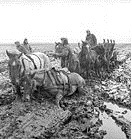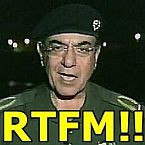MengCiao
Posts: 180
Joined: 7/7/2004
Status: offline

|
quote:
ORIGINAL: ComradeP
quote:
The tricky (and interesting) aspect of the simulation for me will be to see how quickly the Soviets can put together a good (army level at least) command structure to use their tangible resources (such as army-level support units).
A German corps was often worth more than the sum of its parts, due to the "synergy" bonus given by the German operational and tactical system. More units meant more chances of free flowing battles with ad hoc forces and more possibilities in general.
A Soviet Army was often worth less than the sum of its parts, because the leadership was so poor that, say, 8 Rifle divisions were used as a giant armed mob (in all honesty, a Rifle division often wasn't much more than an armed mob), using numbers rather than the possibilities given by having more units to use in an attack. Even those Guards Mechanized and Tank Corps were often more big than flexible, an unstoppable wave of men and machine crushing depleted German formations.
There are historians who say that the Germans were "outgeneraled" by the Soviets during, say Bagration. In my opinion, the Germans were more often outgeneraled by their own generals and often Hitler than by the Soviets as even in 1945, a determined Soviet assault could still be stopped as long as there was a force to stop it with. The main problem was, of course, that such a force wasn't there. Fighting and winning battles you can't lose doesn't make you a good general.
This all may be true, but it seems unwise to assume that this sort of reading of the situation needs to be built into the game from the ground up. It seems to me that the treatment of support units (in HQs and assigned by commanders of variable abilities, with "commander" here perhaps being a shorthand
method for showing the work of communications and staffs and training) might possibly allow for the Soviet player to build up armies that can be as synergistic as a German force (say a corps) of roughly similar size. The Soviets themselves were aware of their problems in late 1941 and early 1942 and fielded simplified rifle divisions and kept support units at the army level precisely in order to get the most out of what they had in terms of support and C&C. My only suggestion about how to make this work at least potentially is that improvement in Soviet communications and communications training and experience be made explicit rather than being absorbed into "commanders" or "morale"...The Soviet player might for example have the option of spending admin points on communications nets or even phantom com nets (as was done for deception) in order to improve the responsiveness and flexibility even of second-rate commanders and third-rate formations.
_____________________________
The corpus of a thousand battles rises from the flood.
|
 Printable Version
Printable Version












 New Messages
New Messages No New Messages
No New Messages Hot Topic w/ New Messages
Hot Topic w/ New Messages Hot Topic w/o New Messages
Hot Topic w/o New Messages Locked w/ New Messages
Locked w/ New Messages Locked w/o New Messages
Locked w/o New Messages Post New Thread
Post New Thread